

Derwent is an 0-6-0 steam locomotive built in 1845 by William and Alfred Kitching for the Stockton and Darlington Railway (S&DR). It is preserved at Darlington Railway Centre and Museum, now known as Head of Steam.


Derwent is an 0-6-0 steam locomotive built in 1845 by William and Alfred Kitching for the Stockton and Darlington Railway (S&DR). It is preserved at Darlington Railway Centre and Museum, now known as Head of Steam.
Derwent was designed by Timothy Hackworth and built by W. & A. Kitching in Darlington, England in 1845. It is similar in design to two of their 1842 locomotives, Leader and Trader, [1] with outside cylinders fixed at the trailing end of the boiler and four-foot diameter, six-wheeled coupled wheels.
Withdrawn from service in 1869, it was sold to Pease & Partners for use on their colliery lines and spent some time at the construction of the Waskerley Reservoir in County Durham. It took part in the Stephenson Centenary celebrations at Newcastle in 1881 and the Queen's Diamond Jubilee in 1887.
Derwent was presented to the North Eastern Railway (NER) in 1898 for preservation. After restoration the locomotive ran under its own steam in the 1925 Railway Centenary procession, and on trials the day before the procession it achieved a speed of 12 mph. [2] Otherwise, for many years, it was on display alongside Locomotion No. 1 on a plinth on one of the platforms at Darlington's main station, Bank Top. In the 1960s, it was removed and restored in near original condition, and then moved in the 1970s to the Darlington Railway Centre and Museum located in the same building as Darlington's North Road railway station, where it remains on display on long-term loan from the National Railway Museum. It is now part of the National Collection.

Stephenson's Rocket is an early steam locomotive of 0-2-2 wheel arrangement. It was built for and won the Rainhill Trials of the Liverpool and Manchester Railway (L&MR), held in October 1829 to show that improved locomotives would be more efficient than stationary steam engines.

Darlington is a market and industrial town in County Durham, England. It is the main administrative centre of the unitary authority Borough of Darlington. The borough is a constituent member of the devolved Tees Valley area.
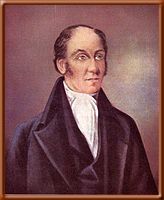
Timothy Hackworth was an English steam locomotive engineer who lived in Shildon, County Durham, England and was the first locomotive superintendent of the Stockton and Darlington Railway.

The National Railway Museum is a museum in York forming part of the Science Museum Group. The museum tells the story of rail transport in Britain and its impact on society. It is the home of the national collection of historically significant railway vehicles such as Mallard, Stirling Single, Duchess of Hamilton and a Japanese bullet train. In addition, the National Railway Museum holds a diverse collection of other objects, from a household recipe book used in George Stephenson's house to film showing a "never-stop railway" developed for the British Empire Exhibition. It has won many awards, including the European Museum of the Year Award in 2001.
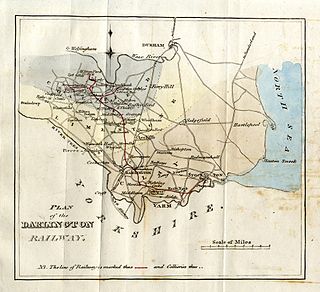
The Stockton and Darlington Railway (S&DR) was a railway company that operated in north-east England from 1825 to 1863. The world's first public railway to use steam locomotives, its first line connected collieries near Shildon with Darlington and Stockton-on-Tees in County Durham, and was officially opened on 27 September 1825. The movement of coal to ships rapidly became a lucrative business, and the line was soon extended to a new port at Middlesbrough. While coal waggons were hauled by steam locomotives from the start, passengers were carried in coaches drawn by horses until carriages hauled by steam locomotives were introduced in 1833.

Shildon is a town and civil parish in County Durham, in England. The population taken at the 2011 Census was 9,976. The town has the Locomotion Museum, due to it having the first station, built in 1825, and locomotive works on the Stockton and Darlington Railway.

Locomotion, previously known as Locomotion the National Railway Museum at Shildon, is a railway museum in Shildon, County Durham, England. The museum was renamed in 2017 when it became part of the Science Museum Group.
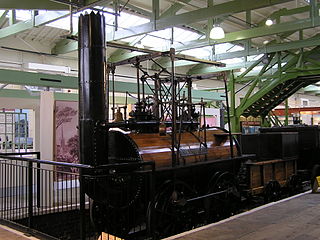

The Liverpool and Manchester Railway (LMR) 57 Lion is an early 0-4-2 steam locomotive, which had a top speed of 40 mph (64 km/h) and could pull up to 200 tons. One of a pair designed for hauling freight, Lion was built by Todd, Kitson & Laird of Leeds in 1838. It featured in the 1953 Ealing comedy, The Titfield Thunderbolt.

Great Western Railway (GWR) 6000 Class King George V is a preserved British steam locomotive.
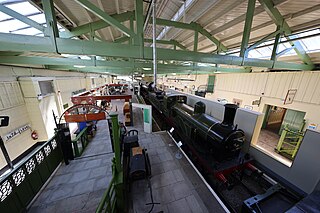
Head of Steam, formerly known as the Darlington Railway Centre and Museum, is a railway museum located on the 1825 route of the Stockton and Darlington Railway, which was the world's first steam-powered passenger railway. It is based inside the station building at the North Road railway station. Its exhibits are devoted to the area formerly served by the North Eastern Railway with a particular focus on the Stockton & Darlington Railway and the railway industry of Darlington.In 2022 plans were submitted to expand the museum as part of the Railway Heritage Quarter.


Wylam Dilly is the second oldest surviving railway locomotive in the world; it was built circa 1815 by William Hedley and Timothy Hackworth for Christopher Blackett, the owner of Wylam colliery, west of Newcastle upon Tyne. Wylam Dilly was initially designed for and used on the Wylam Waggonway to transport coal. The four driving wheels are connected by a train of spur wheels driven by a central crankshaft.
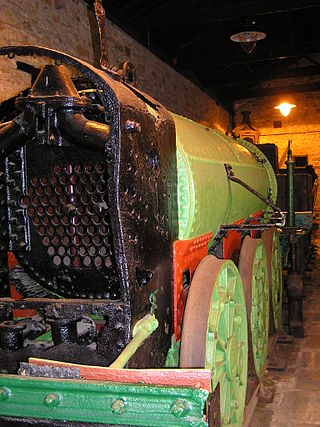
Bradyll is an early steam locomotive built by Timothy Hackworth at his Soho Works in Shildon, England in 1840. She is the oldest surviving locomotive with an 0-6-0 wheel arrangement.
Whessoe is a company based in Darlington and on Teesside in North East England. It was formerly a supplier of chemical, oil and nuclear plant and instrumentation, and today is a manufacturer of low temperature storage.
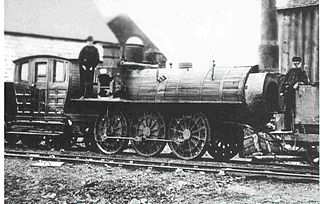
The Samson is an English-built railroad steam locomotive made in 1838 that ran on the Albion Mines Railway in Nova Scotia, Canada. It is preserved at the Nova Scotia Museum of Industry in Stellarton, Nova Scotia and is the oldest locomotive in Canada.
There were a number of engine sheds and railway works located in York. The large York North engine shed became the National Railway Museum in 1975.

The 1825 to 1863 Stockton and Darlington Railway (S&DR) was world's first public railway to use steam locomotives, its first line connected collieries near Shildon with Stockton-on-Tees and Darlington, and was officially opened on 27 September 1825. While coal waggons were hauled by steam locomotives from the start, passengers were carried in coaches drawn by horses until carriages hauled by steam locomotives were introduced in 1833.
Hackworth Park is a park in Shildon, County Durham, England. It was named after Timothy Hackworth, a railway pioneer from the town.

The Pays de Waes is a preserved tank locomotive built in 1844, which is part of the historical collection of the National Railway Company of Belgium (SNCB), on display at Train World. It is reputed to be the oldest preserved locomotive on the European continent.